|
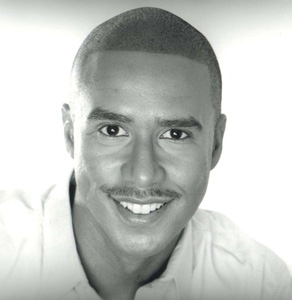 Cyber-Interview of
the Month: Cyber-Interview of
the Month:
Rodney
Lopez
-by Manny
Siverio
Originally published on SalsaNewYork on 10/02
This Month we interview NY Mambo Performer
and Instructor Rodney Lopez.
Rodney has been involved in the NY Dance scene for several years where he has
been teaching regularly over at Dance Manhattan. He is currently a member of Addie
Diaz's Addie-tude Dance
Company, has recently been added to SalsaNewYork's
Online Directory of On2 Instructors and has the distinction of being a new
cast member to the off-Broadway Mambo Musical Latin
Madness III.
Cyber-Interview: Rodney
Lopez
How
long have you been dancing mambo and what got you into it?
Ive been dancing salsa/mambo for
about seven years. Eleanor Lopez,
a longtime friend, introduced me to the New York salsa scene.
It was those long nights being a wallflower that finally prompted me to
learn how to dance.
Where did you
originally learn how to dance mambo and who was (were) your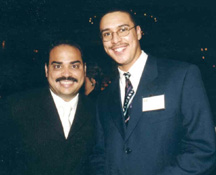 mentors?
mentors?
Eleanor taught me my first steps,
while instructors such as Eddie
and Maria Torres, Nelson
Flores, and Wilton Beltre were my first classroom teachers.
Ive tried to emulate many of these instructors
in my dancing and teaching. I
also consider Teddy Kern, Artistic Director of Dance Manhattan, one of my
dance mentors.
How long have you been
teaching mambo and what made you decide to teach mambo?
Ive been teaching for a little over five years.
I fell into teaching quite by accident.
I was assisting with a group called Sanando
through The Arts in the Lower East Side.
I got the bug and the rest is history.
Ive been at Dance Manhattan for about four years.
What
do you like most about teaching?
Seeing a student progress from the
stage of nervous beginner to competent social dancer.
There are fewer things that are more satisfying than that. Its a privilege to be able to contribute to someones
personal development and dance is an important part of many peoples lives.
It also reminds me of my learning process.
Why
do you think people come to learn from you?
Id like to think that people enjoy
my teaching style. I try my best
to be as informative and entertaining as possible.
While I want my students to become good technical dancers, I want them
to have fun too.
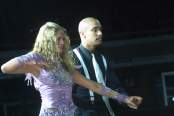 Are
most of your students men or women? and why is that? Are
most of your students men or women? and why is that?
At one point early on, I had mostly
women students. But I teach many
more men these days. I think guys
have finally realized that one of the best ways to meet women is through
dance.
What is the hardest thing you find about teaching?
The hardest thing is coming up with
the right material for your classes and teaching it in a way that is enjoyable
and interesting. Its also
difficult dealing with people who are not at the appropriate class level.
Do
you still like to go to clubs and dance socially?
I still enjoy social dancing at clubs
and socials, but my teaching
schedule often prevents me from going out as much as Id like.
How about performing?
Do you still perform and whom have you performed for or with?
I enjoy performing tremendously. Ive had the pleasure of performing with several partners
at numerous social and corporate affairs through Dance Manhattan.
Ive also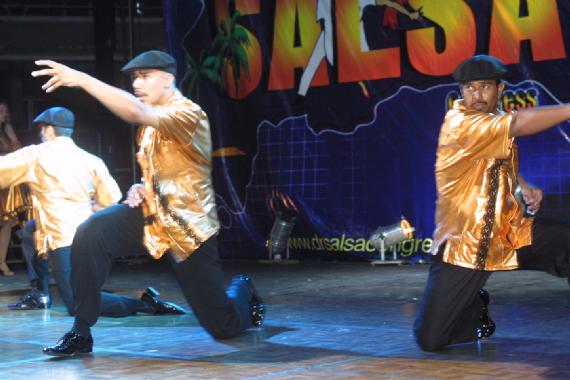 performed extensively with the Addie-Tude
Dance Company since joining Addie
Diazs team this year. I
also perform quite a bit with Mariana Parma, my Dance Manhattan teaching
partner and Brett McNichols,
my 'partner-in-crime' at the Addie-Tude
Dance
performed extensively with the Addie-Tude
Dance Company since joining Addie
Diazs team this year. I
also perform quite a bit with Mariana Parma, my Dance Manhattan teaching
partner and Brett McNichols,
my 'partner-in-crime' at the Addie-Tude
Dance
Company.".
Name
your favorite on stage performance?
I actually have two favorite salsa
performances. Ive had the
privilege of performing in one of them. Addie-Tudes
Muñeca is one of the most
creative and technically challenging performances Ive seen in any dance
style. It is a visual spectacle
that retains its New York salsa street cred.
The other is Wilton Beltres Soneros
de Bailadores routine. It is
a very musical and exciting piece of choreography, and now that I have the
privilege of being a member of the 2002 cast of Latin
Madness, I have the opportunity to perform in that number on a regular
basis - something I've wanted to do for a long time.
What
got you into performing and what was your first time on stage?
Im kind of a ham, so once I
started dancing it was only a matter of time before I would try to put some of
the steps on stage. My first
salsa performance was for an international culture celebration at my former
job in 1996. Eleanor, Negra and I
danced to Johnnys Mambo from Dirty Dancing.
Nothing is more nerve-wracking than performing in front of your boss
and colleagues. Looking back at
that choreography is unbearable now.
What
did you feel when you first performed live on stage?
Terror, fright and a little nausea.
Have
you ever choreographed a routine?
Ive had the pleasure of
choreographing routines for several student performance teams at Dance
Manhattan. Ive also
choreographed or co-choreographed routines with different dance partners.
What
do you like about being a dance choreographer?
Choreography is a rare opportunity to
communicate to an audience your own relationship to a piece of music. What starts with an idea in your head becomes a living,
breathing expression of performance art.
I absolutely love doing it.
 What
do you look for in a song when you are putting choreography together for it? What
do you look for in a song when you are putting choreography together for it?
I look for a story, a funky groove,
and cool breaks. Unlike many
routines that Ive seen, I dont believe that speed is the most important
thing in a dance routine. Nobody
cares if you can do a million moves a minute; I believe people appreciate a
performance that is musical.
Have
you traveled to teach workshops and seminars? If so where have you gone?
To date, all of my dance workshops
have been in the New York tri-state area.
Id like to teach in some other areas at some point.
What is the difference
between teaching a regular class and special one-shot workshop/seminar?
A one-time seminar requires a
different kind of preparation. Since
youve only got your students for one or two hours, you want to make sure
they leave feeling theyve learned something specific something they can
apply to their dancing immediately. In
a weekly class, if you dont
get something this week, you can always review it next class.
Which gives you the
best joy? Teaching, performing or putting together choreography?
Although choreography is fun, it
isnt always easy to come up with fresh ideas.
Teaching is probably most enjoyable since I see results of some sort
every week.
How
is it that you prepare yourself for a workshop? and for a performance?
I prepare for a workshop by thinking
about my students and their level of dance and trying my best to teach
appropriate material. I prepare
for a performance by rehearsing as much as I can and remembering that its
important to have a good time on stage.
What advice would you
give those just getting into mambo? How can they work at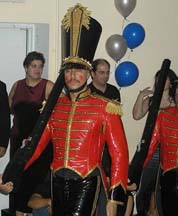 getting better at dancing?
getting better at dancing?
Have fun with the dance, meet and
dance with as many people as possible and LISTEN TO THE MUSIC.
Theres no dance without music so its important to be as
knowledgeable as you can.
How
best could you describe your way of dancing? of teaching? and of performing?
My dancing is kind of goofy
funky I dont take myself too seriously so I just dance and try to
have the best time I can. I do
take my teaching seriously and think I have a thoughtful and technical
teaching style. I like to explain as much as I can, since thats the way I
like to learn. I try to dance as
naturally as I can when performing.
How is New York Mambo
dancing different from mambo dancing in other parts of the country?
New York salsa/mambo dancers have an
almost religious preference for breaking on two.
But whats great is that you can find all kinds of salsa dancing in
New York because of its history in this city.
Theres a place to go dancing every night.
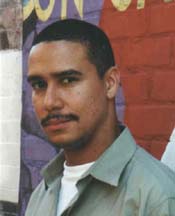 Do
you think that dancers get treated with respect? If not why? Do
you think that dancers get treated with respect? If not why?
I think dancers are getting more of
the respect they deserve. Especially
since social dancing has re-emerged as an important leisure activity, dancers
and dance teachers are getting more
props.
What would you like to
see happen to mambo within the next few years?, next decade? within your
lifetime?
Id like to see mambo continue to
be exported across the world. Id
also like to see a salsa museum in East Harlem or the South Bronx to honor all
of the great musicians and dancers that have contributed to this art form.
Click here for
Rodney's current contact info.
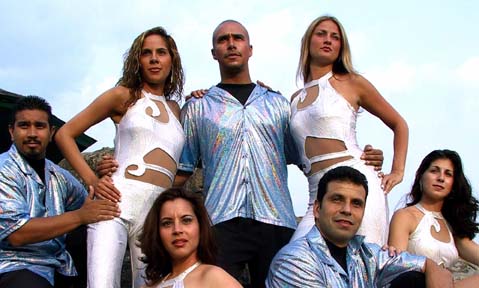
Rodney (center) posing with Addie Diaz and other
members of the Addie-tude Dance Company
Photo courtesy of Mambon2.com
[Main
Menu ] [Magazine
Home ] [New
Articles this month ] [Instructors
] [NY Dance News]
[Articles]
[Submit
an Article] [Calendar
of Dance Events]
Best Viewed In Internet Explorer
|


![]()